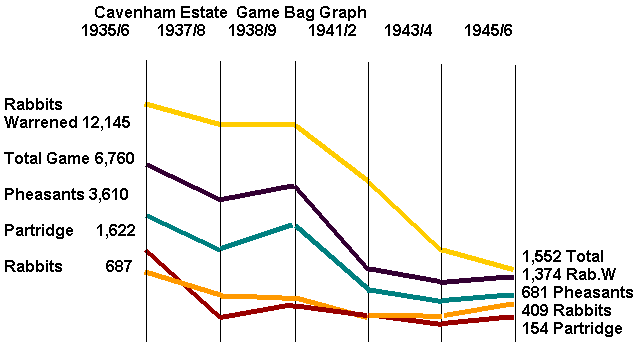The Estate Workshop
The Estate Workshop lies to the north of the milking sheds and was
traditionally used to refurbish the estate dwellings and supply their
distinctive tongue and groove interior panelling.
In the 1930’s a building attached to one side of the workshop was used as a
game larder. Here the head gamekeeper Jennings and his under keepers and
warreners Fred Gooch and ‘Willy’ Staff hung all the game which were then
collected by G. A. Thornalley the game dealer from Worlington.
Recollections of George Thornalley the Game Dealer
George A. Thornalley’s son, also a George, recalls the working habits of
his father and grandfather, Carden.
“At the turn of the century Carden was the warrener for Cavenham Heath
capturing the rabbits and hares with snares, nets, gin traps and ferrets”
selling them door to door straight from the pole hung over his shoulders. After
sale he would skin the animal on the doorstep taking the pelts up to the Brandon
factories of ‘Lingwood’ and ‘Rought - Rought’. The rabbit pelts, which
were worth more than the meat, were prepared for export far and wide where they
were turned into felt hats. “
Carden was known for his interest in whisky and George’s mother claimed he
hid a bottle down each rabbit hole. George jokes; “are there any empty
whisky bottles now on Cavenham Heath?”
In time George became the local game dealer visiting Cavenham once a day to
collect 100 wild rabbits and many pheasants. His son recalls..
“In total my father, George dealt with 10,000 wild rabbits and 2, 000
pheasants per week. His main rabbit outlet was the motor industrial town of
Luton where he journeyed three times a week. The pheasants went to large hotels
and many transatlantic liners of the day...Selling the rabbits for between 6d
and 1 shilling.... a 75% profit on each rabbit was made, making this more
profitable than agricultural work. Working through from August to March he was
free in the summer months to tend his garden and play bowls”.
George would accompany his father on these trips and was struck by his
ability to recognise the source of any rabbit. Once there was a cross breed of
rabbit sold from Cavenham workshop with a white brown patch (probably 5% pet)
for some reason these were an embarrassment to his father. Cavenham pheasants,
on the other hand, were the best quality he ever had. The business did not
appeal to George and he became a farmer. Receiving the following advice from the
manager of the day:
“When you hire 40 odd workers to pick the sugar beet leave them for a
couple of hours and then sack the first 3 or 4 you see however well they are
working, this will set things right for the rest of the season”.
